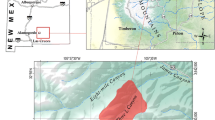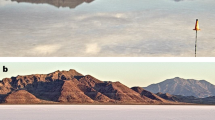Abstract
Water loss by evapotranspiration (ET) is a principal component of the hydrologic cycle in wetlands. Using micrometeorological techniques, we measured ET from a Sphagnum-dominated open fen in northcentral Minnesota (U.S.A.) from May to October in 1991 and 1992. The daily ET rate ranged from 0.2–4.8 mm d-1 with a growing season average of 3.0 mm d-1. The evapotranspiration rate of the fen was near the potential rate of open water evaporation when the vascular plants were actively growing and the water table level was within or above the rooting zone. Using a dual-source modification of the Penman-Monteith equation (Massman, 1992), we partitioned the measured ET into evaporation from the non-vascular Sphagnum surfaces and transpiration from vascular plants. The analysis indicated that about two thirds of the water vapour flux to the atmosphere was from evaporation when the Sphagnum surface was wet. Such an evaporative flux was expected because of vertical distribution of vascular plant leaves which had a small leaf area index (0.4–0.7) and intercepted only about 30% of net radiation (R n ) during the day. The remainder of R n was thus available for evaporation from Sphagnum. Evaporation significantly decreased as the Sphagnum surface dried out. When the water table was within the rooting zone (0–0.4 m), the vascular plants absorbed Sphagnum-generated sensible heat, which amounted up to one third of their transpiration energy flux. Under these conditions, the total water vapour flux remained near its potential rate owing to the enhanced transpiration from vascular plants. A drop in water table of 0.15–0.2 m below the hollow bottom during vascular plant senescence resulted in ET rates lower than the potential rates by 5–65%.
Similar content being viewed by others
References
Berglund, E. R. and Mace, A. C. Jr.: 1972, ‘Seasonal Albedo Variation of Black Spruce and Sphagnum- sedge Bog Cover Types’, J. Appl. Meteorol. 11, 806–812.
Boelter, D. H. and Verry, E. S.: 1977, ‘Peatland and Water in the Northern Lake States’, USDA For. Serv. Gen. Tech. Rep. NC-31, 22 pp., North Cent. For. Exp. Stn., St. Paul, Minnesota.
Bradley, E. R.: 1972, ‘The Influence of Thermal Stability on a Drag Coefficient Measured Close to the Ground’, Agric. Meteorol. 9, 183–190.
Camillo, P. J. and Gurney, R. J.: 1986, ‘A Resistance Parameter for Bare-soil Evaporation Models’, Soil Sci. 141, 95–105.
Chapman, S. B.: 1965, ‘The Ecology of Coom Rigg Moss. Northumberland III. Some Water Relations of the Bog System’, J. Ecol. 53, 371–384.
Deacon, E. L. and Swinbank, W. C.: 1958, ‘Comparison between Momentum and Water Transfer’, in Proc. Symp. Arid Zone Research, UNESCO, Paris, pp. 38–41.
Finnigan, J. J. and Raupach, M. R.: 1987, ‘Transfer Processes in Plant Canopies in Relation to Stomatal Characteristics’, in E. Zeiger, G. Farquhar, and I. Cowan (eds.), Stomatal Function, Stanford University Press, Stanford, CA, pp. 385–429.
Gorham, E.: 1991, ‘Northern Peatlands: Role in the Carbon Cycle and Probable Responses to Climatic Warming’, Ecological Applications 1, 182–195.
Ham, J. M. and Heilman, J. L.: 1991, ‘Aerodynamic and Surface Resistances Affecting Energy Transport in a Sparse Crop’, Agric. For. Meteorol. 53, 267–284.
Hartman, R. K. and Gay, L. W.: 1981, ‘Improvements in the Design and the Calibration of Temperature Measurement System’, Proc. 15th Conference on Agricultural and Forest Meteorology, 210 pp.
Ingram, H. A. P.: 1983, ‘Hydrology’, in A. J. P. Gore (ed.), Mires: Swamp, Bog, Fen, and Moor, Elsevier Scientific, New York, pp. 67–158.
Jacobs, A. F. G. and Van Pul, W. A. J.: 1990, ‘Seasonal Changes in the Albedo of a Maize Crop during Two Seasons’, Agric. For. Meteorol. 49, 351–360.
Jarvis, P. G. and McNaughton, K. G.: 1986, ‘Stomatal Control of Transpiration: Scaling Up from Leaf to Region’, Adv. Ecol. Res. 15, 1–49.
Kelliher, F. M., Leuning, R. and Schulze, E. D.: 1993, ‘Evaporation and Canopy Characteristics of Coniferous Forests and Grasslands’, Oecologia 95, 153–163.
Kelliher, F. M., Luening, R., Raupach, M. R., and Schulze, E.-D.: 1995, ‘Maximum Conductances for Evaporation from Global Vegetation Types’, Agric. For. Meteorol. 73, 1–16.
Kim, J. and Verma, S. B.: 1990, ‘Components of Surface Energy Balance in a Temperate Grassland Ecosystem’, Boundary-Layer Meteorol. 51, 401–417.
Kim, J. and Verma, S. B.: 1992, ‘Soil Surface CO2 Flux in a Minnesota Peatland’, Biogeochem. 18, 37–51.
Kimball, B. A., Jackson, R. D., Nakayama, F. S., Idso, S. B., and Reginato, R. J.: 1976, ‘Soil Heat Flux Determination: Temperature Gradient Method with Computed Thermal Conductivities’, Soil Sci. Soc. Am. J. 40, 25–28.
Koerselman, W. and Beltman, B.: 1988, ‘Evapotranspiration from Fens in Relation to Penman's Potential Free Water Evaporation and Pan Evaporation’, Aquatic Botany 31, 307–320.
Lafleur, P. M.: 1988, ‘Leaf Conductance of Four Species Growing in a Subarctic Marsh’, Can. J. Bot. 66, 1367–1375.
Lafleur, P. M.: 1990, ‘Evaporation from Wetland’, in N. T. Roulet (ed.), Focus: Aspects of the Physical Geography of Wetland, Can. Geographer 34, 79–88.
Lafleur, P. M. and Rouse, W. R.: 1990, ‘Application of an Energy Combination Model for Evaporation from Sparse Canopies’, Agric. For. Meteorol. 49, 135–153.
Lafleur, P. M. and Roulet, N. T.: 1992, ‘A Comparison of Evaporation Rates from Two Fens of the Hudson Bay Lowland’, Aquatic Botany 44, 59–69.
Massman, W. J.: 1992, ‘A Surface Energy Balance Method for Partitioning Evapotranspiration Data into Plant and Soil Components for a Surface with Partial Canopy Cover’, Water Res. Research 28, 1723–1732.
Massman, W. J. and Ham, J. M.: 1994, ‘An Evaluation of a Surface Energy Balance Method for Partitioning ET Data into Plant and Soil Components for a Surface with Partial Canopy Cover’, Agric. For. Meteorol. 67, 253–267.
McNaughton, K. G. and Jarvis, P. G.: 1983, ‘Predicting Effects of Vegetation Changes on Transpiration and Evaporation’, Water Deficits and Plant Growth 7, 1–47.
Monteith, J. L.: 1965, ‘Evaporation and Environment’, Symp. Soc. Exp. Biol. XIX, Cambridge University Press, London, pp. 205–403.
Monteith, J. L. and Unsworth, M. H.: 1990, Principles of Environmental Physics, 2nd Ed., Edward Arnold, London, 291 pp.
Moore, K. E., Fitzjarrald, D. R., Wofsy, S. C., Daube, B. C., Munger, J. W., Bawkin, P. S., and Crill, P.: 1994, ‘A Season of Heat, Water Vapor, Total Hydrocarbon, and Ozone Fluxes at a Subarctic Fen’, J. Geophys. Res. 99, 1937–1952.
Moore, T. R. and Knowles, R.: 1989, ‘The Influence of Water Table Levels on Methane and Carbon Dioxide Emissions from Peatland Soils’, Canadian J. Soil Science 69, 33–38.
Nichols, D. S. and Brown, J. M.: 1980, ‘Evaporation from a Sphagnum Moss Surface’, J. Hydrol. 48, 289–302.
Nichols, W. D.: 1992, ‘Energy Budgets and Resistances to Energy Transport in Sparsely Vegetated Rangeland’, Agric. For. Meteorol. 60, 221–247.
Penman, H. L.: 1948, ‘Natural Evapotranspiration from Open Water, Bare Soil and Grass’, Proc. R. Soc. London, Ser. A 193, 120–145.
Philip, J. R.: 1987, ‘Advection, Evaporation, and Surface Resistance’, Irrig. Sci. 8, 101–114.
Price, J. S.: 1991, ‘Evaporation from a Blanket Bog in a Foggy Coastal Environment’, Boundary-Layer Meteorol. 57, 391–406.
Priestley, C. H. B. and Taylor, R. J.: 1972, ‘On the Assessment of Surface Heat Flux and Evaporation Using Large-Scale Parameters’, Mon. Weat. Rev. 100, 81–92.
Raupach, M. R. and Finnigan, J. J.: 1988, ‘Single-Layer Models of Evaporation from Plant Canopies are Incorrect but Useful, whereas Multilayer Models are Correct but Useless: Discuss’, Aust. J. Physiol. 15, 705–716.
Romanov, V. V.: 1968, ‘Hydrology of Bogs’, Israel Program for Scientific Translations, Jerusalem, 299 pp.
Sene, K. J.: 1994, ‘Parameterizations for Energy Transfer from a Sparse Vine Crop’, Agric. For. Meteorol. 71, 1–18.
Shurpali, N. J., Verma, S. B., Kim, J., and Arkebauer, T. J.: 1995, ‘Carbon Dioxide Exchange in a Peatland Ecosystem’, J. Geophys. Res. 100, 14319–14326.
Shuttleworth, W. J. and Wallace, J. S.: 1985, ‘Evaporation from Sparse Crops - An Energy Combination Theory’, Quart. J. Roy. Meteorol. Soc. 111, 839–855.
Stannard, D. I.: 1993, ‘Comparison of Penman-Monteith, Shuttleworth-Wallace, and Modified Priestley-Taylor Evapotranspiration Models for Wildland Vegetation in Semiarid Rangeland’, Water Res. Research 29, 1379–1392.
Sturges, D. L.: 1968, ‘Evapotranspiration at a Wyoming Mountain Bog’, J. Soil Water Conserv., January–February, pp23-25.
Titus, J. E. and Wagner, D. J.: 1984, ‘Carbon Balance for Two Sphagnum Mosses: Water Balance Resolves a Physiological Paradox’, Ecology, 65, 1765–1774.
Verry, E. S.: 1975, ‘Streamflow Chemistry and Nutrient Yields from Upland-Peatland Watersheds in Minnesota’, Ecology 56, 1149–1157.
Verry, E. S.: 1988, ‘Hydrology of Wetlands and Men's Influence on It’, in Symposium on the Hydrology of Wetlands in Temperate and Cold Regions, Vol. 2, Publications of the Academy of Finland (Helsinki), 5, 41–61.
Verry, E. S. and Timmons, D. R.: 1982, ‘Waterborne Nutrient Flow through an upland-peatland watershed in Minnesota’. Ecology 63, 1456–1467.
Wesely, M. L. and Hicks, B. B.: 1977, ‘Some Factors that Affect the Deposition Rates of Sulfur Dioxide and Similar Gases on Vegetation’, J. Air Pollution Control Assoc. 27, 1110–1115.
Author information
Authors and Affiliations
Rights and permissions
About this article
Cite this article
Kim, J., Verma, S.B. Surface exchange of water vapour between an open sphagnum fen and the atmosphere. Boundary-Layer Meteorol 79, 243–264 (1996). https://doi.org/10.1007/BF00119440
Accepted:
Issue Date:
DOI: https://doi.org/10.1007/BF00119440




